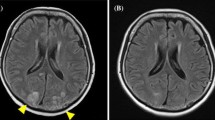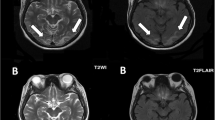Abstract
We report on a child with B-cell lymphoma who developed hypertension and reversible posterior leukoencephalopathy syndrome (RPLS) after chemotherapy conducted during recovery from tumor lysis syndrome. After recovery from RPLS, the patient received further combination chemotherapy without recurrence of the neurological signs or symptoms suggestive of RPLS. Many etiological factors have been reported in the development of RPLS; however, little attention has been paid to tumor lysis syndrome as a contributory factor for RPLS. Tumor lysis syndrome can precipitate the development of RPLS in patients with hematological malignancies who are undergoing chemotherapy. Knowledge and awareness would help facilitate immediate management such as normalization of blood pressure and temporary cessation of chemotherapy, helping to avoid irreversible brain damage.


Similar content being viewed by others
References
Hinchey J, Chaves C, Appignani B, et al (1996) A reversible posterior leukoencephalopathy syndrome. N Engl J Med 334:494–500
Ay H, Buonanno FS, Schaefer PW, et al (1998) Posterior leukoencephalopathy without severe hypertension: utility of diffusion-weighted MRI. Neurology 51:1369–1376
Casey SO, Sampaio RC, Michel E, et al (2000) Posterior reversible encephalopathy syndrome: utility of fluid-attenuated inversion recovery MR imaging in the detection of cortical and subcortical lesions. AJNR 21:1199–1206
Covarrubias DJ, Luetmer PH, Campeau NG (2000) Posterior reversible encephalopathy syndrome: prognostic utility of quantitative diffusion-weighted MR images. AJNR 23:1038–1048
Schwartz RB, Feske SK, Polak JF, et al (2000) Preeclampsia-eclampsia: clinical and neuroradiographic correlates and insights into the pathogenesis of hypertensive encephalopathy. Radiology 217:371–376
Jones BV, Egelhoff JC, Patterson RJ (1997) Hypertensive encephalopathy in children. AJNR 18:101–106
Shin RK, Stern JW, Janss AJ, et al (2001) Reversible posterior leukoencephalopathy during the treatment of acute lymphoblastic leukemia. Neurology 56:388–391
Honkaniemi J, Kahara V, Dastidar P, et al (2000) Reversible posterior leukoencephalopathy after combination chemotherapy. Neuroradiology 42:895–899
Edwards MJJ, Walker R, Vinnicombe S, et al (2001) Reversible posterior leukoencephalopathy syndrome following CHOP chemotherapy for diffuse large B-cell lymphoma. Ann Oncol 12:1327–1329
Ito Y, Arahata Y, Goto Y, et al (1998) Cisplatin neurotoxicity presenting as reversible posterior leukoencephalopathy syndrome. AJNR 19:415–417
Russell MT, Nassif AS, Cacayorin ED, et al (2001) Gemcitabine-associated posterior reversible encephalopathy syndrome: MR imaging and MR spectroscopy findings. Magn Reson Imaging 19:129–132
Bakshi R, Shaikh ZA, Bates VE, et al (1999) Thrombotic thrombocytopenic purpura: brain CT and MRI findings in 12 patients. Neurology 52:1285–1288
Woolfenden AR, Hukin J, Poskitt KJ, et al (1998) Encephalopathy complicating Henoch-Schönlein purpura: reversible MRI changes. Pediatr Neurol 19:74–77
Utz N, Kinkel B, Hedde JP, et al (2001) MR imaging of acute intermittent porphyria mimicking reversible posterior leukoencephalopathy syndrome. Neuroradiology 43:1059–1062
Kastrup O, Maschke M, Wanke I, et al (2002) Posterior reversible encephalopathy syndrome due to severe hypercalcemia. J Neurol 249:1563–1566
Kwon S, Koo J, Lee S (2001) Clinical spectrum of reversible posterior leukoencephalopathy syndrome. Pediatr Neurol 243:61–64
Bakshi R, Bates VE, Mechtler LL, et al (1998) Occipital lobe seizures as the major clinical manifestation of reversible posterior leukoencephalopathy syndrome: magnetic resonance imaging findings. Epilepsia 39:295–299
Greenwood MJ, Dodds AJ, Garricik R, et al (2003) Posterior leukoencephalopathy in association with the tumour lysis syndrome in acute lymphoblastic leukaemia—a case with clinicopathological correlation. Leuk Lymphoma 44:719–721
Jeha S (2001) Tumor lysis syndrome. Semin Hematol 38[Suppl 10]:4–8
Yarpuzlu AA (2003) A review of clinical and laboratory findings and treatment of tumor lysis syndrome. Clin Chim Acta 333:13–18
Bargallo N, Burrel M, Berenguer J, et al (2000) Cortical laminar necrosis caused by immunosuppressive therapy and chemotherapy. AJNR 21:479–484
Author information
Authors and Affiliations
Corresponding author
Rights and permissions
About this article
Cite this article
Kaito, E., Terae, S., Kobayashi, R. et al. The role of tumor lysis in reversible posterior leukoencephalopathy syndrome. Pediatr Radiol 35, 722–727 (2005). https://doi.org/10.1007/s00247-005-1434-6
Received:
Revised:
Accepted:
Published:
Issue Date:
DOI: https://doi.org/10.1007/s00247-005-1434-6




